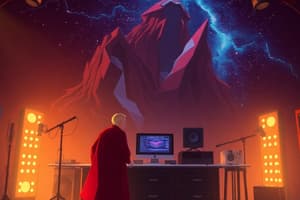Podcast
Questions and Answers
What is the definition of diegetic sound in cinema?
What is the definition of diegetic sound in cinema?
- Sound that is only perceived by the audience.
- Sound that comes from outside the story space.
- Sound that includes music played during the credits.
- Sound that characters can hear within the story. (correct)
Which editing technique is characterized by cutting between different sets of action occurring simultaneously?
Which editing technique is characterized by cutting between different sets of action occurring simultaneously?
- Linear Editing
- Parallel Editing
- Cross-Cutting (correct)
- Montage Editing
What is the purpose of rack focusing in a film scene?
What is the purpose of rack focusing in a film scene?
- To keep all elements of the scene in focus.
- To create a sense of chaos within the scene.
- To direct the viewer's attention from one subject to another. (correct)
- To increase the depth of field.
Which term describes a technique where both near and far objects in a scene are in focus?
Which term describes a technique where both near and far objects in a scene are in focus?
What does continuity editing aim to achieve in filmmaking?
What does continuity editing aim to achieve in filmmaking?
Which of the following best describes mise-en-scène?
Which of the following best describes mise-en-scène?
How is non-diegetic sound defined in relation to a film's narrative?
How is non-diegetic sound defined in relation to a film's narrative?
What is the primary function of a dolly in filmmaking?
What is the primary function of a dolly in filmmaking?
What is the primary function of the axis of action or 180-degree line in cinematography?
What is the primary function of the axis of action or 180-degree line in cinematography?
Which term describes the technique of omitting certain periods of time in a film's narrative?
Which term describes the technique of omitting certain periods of time in a film's narrative?
What distinguishes a jump cut from a regular cut in film editing?
What distinguishes a jump cut from a regular cut in film editing?
How does a dissolve transition function in film?
How does a dissolve transition function in film?
What is the defining characteristic of a wipe transition?
What is the defining characteristic of a wipe transition?
What does a flashback sequence typically do in a film?
What does a flashback sequence typically do in a film?
What role does an establishing shot play in a scene?
What role does an establishing shot play in a scene?
What is the purpose of a point of view shot (POV) in filmmaking?
What is the purpose of a point of view shot (POV) in filmmaking?
Flashcards are hidden until you start studying
Study Notes
Diegetic Sound
- Sound that originates from within the story world.
- The characters and the audience can both hear it.
- Commonly referred to as "literal sound" or "actual sound".
Non-Diegetic Sound
- Sound that originates from outside the story world.
- The audience can hear it, but the characters cannot.
Mystery and Suspense
- Mystery: The narrative presents effects while withholding causes.
- Suspense: The narrative presents causes while withholding effects.
Cross-Cutting
- Cutting between different sets of action that can be occurring simultaneously or at different times.
Depth of Field (DOF)
- The distance between the nearest and farthest objects in a scene that appear acceptably sharp in an image.
Deep Focus
- A technique where both near and far objects in a scene are in focus.
Shallow Focus
- A technique where only one plane of the image is in focus, while the rest is out of focus.
Rack Focusing
- A technique that uses shallow focus to shift the viewer's attention from one subject to another.
Dolly
- A set of wheels and a platform that allows the camera to move.
Editing
- The process of selecting and joining together different shots.
Mise-en-Scène
- French for "putting into the scene," it encompasses every detail within the frame of the film.
- Includes setting, colors, brightness, location, costumes, staging of actors, direction of actors, camera angles, choice of lenses, and sound.
Continuity Editing
- Editing techniques used to ensure the spatial orientation of the viewer.
- Constructs the scene's space along an "axis of action" (also known as the "180-degree Line").
- The axis of action determines a 180-degree area where the camera can be placed to present the action.
Axis of Action (180° Line)
- An imaginary line drawn between two points of interest or action.
- Cameras are typically placed on one side of the axis to maintain screen position, direction, and eyeline consistency.
Ellipsis
- Refers to periods of time that are left out of the narrative.
Jump Cut
- An abrupt cut between two shots that draws attention to itself due to the lack of seamless matching.
Dissolve
- A transition between scenes or sequences achieved by briefly superimposing the end of one shot onto the beginning of the next.
Wipe
- Shot B replaces shot A by means of a boundary line moving across the screen.
Flashback
- A scene or sequence that is inserted into present-day action to depict an event from the past.
Flash-Forward
- A scene or sequence inserted into present-day action to depict an event from the future.
Establishing Shot
- Sets up the context for a scene by showing the relationship between important figures and objects.
- Often used at the beginning of a scene to establish the location and setting.
Point of View Shot (POV)
- A subjective shot showing the scene from the perspective of a character.
Studying That Suits You
Use AI to generate personalized quizzes and flashcards to suit your learning preferences.




